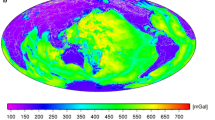Abstract.
The spherical harmonic analysis of the 2∘×2∘ density and stratification information contained in the global crustal model CRUST 2.0 is presented from the viewpoint of gravity field recovery and interpretation. Using a standard Airy/Heiskanen (A/H) isostatic hypothesis and a radially distributed compensation mechanism, two models of topographic/isostatic (t/i) potential harmonic coefficients are obtained up to degree and order 90. The CRUST-derived coefficients are compared with the spectrum of uncompensated topography, with the EGM96 observed gravity field, and with the t/i spectrum based on an A/H hypothesis with a constant compensation depth of 30 km. The signal degree variances of both CRUST models decrease quite smoothly towards degree 90, while the seven-layer model approaches the EGM96 spectrum for degrees 80–90. The significant deviation of the CRUST spectra from the A/H combined spectrum may prove of relevance to local and regional applications investigating the validity of current isostatic hypotheses.
Similar content being viewed by others
Author information
Authors and Affiliations
Corresponding author
Additional information
Acknowledgments. Sincere thanks go to Nikolaos Pavlis and three unknown referees for their thoughtful comments. Figure 1 has been produced using the mapping package m_map by R. Pawlowicz, which is a MATLAB toolbox that can be freely downloaded from http://www2.ocgy.ubc.ca/~rich/map.html
Rights and permissions
About this article
Cite this article
Tsoulis, D. Spherical harmonic analysis of the CRUST 2.0 global crustal model. Journal of Geodesy 78, 7–11 (2004). https://doi.org/10.1007/s00190-003-0360-3
Received:
Accepted:
Published:
Issue Date:
DOI: https://doi.org/10.1007/s00190-003-0360-3




